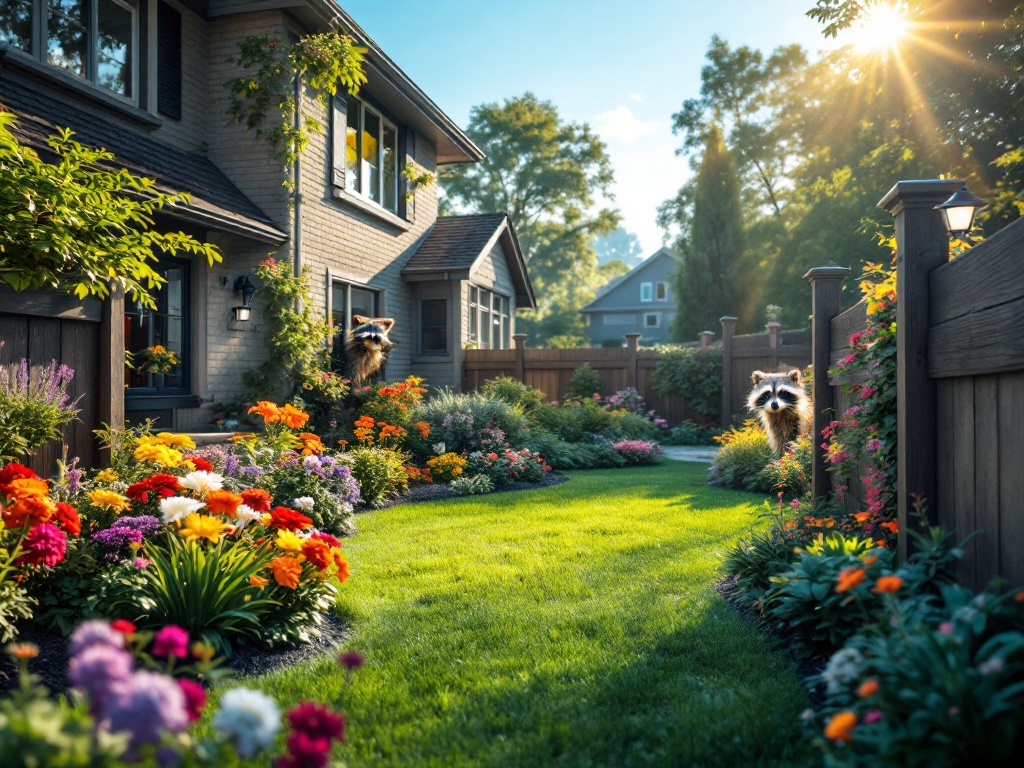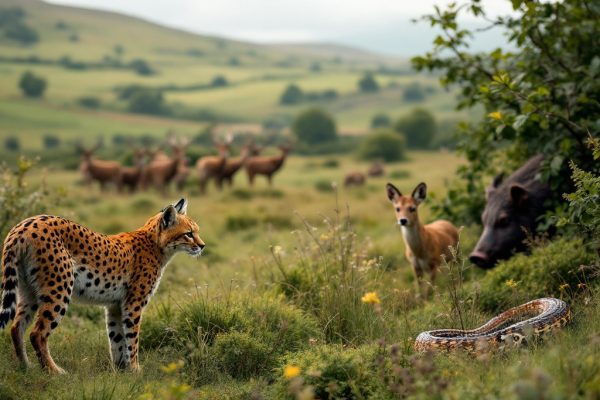How Do You Keep Wild Animals away from Your House in Lothian?
Are you concerned about the risks of wild animals near your home? From raccoons tearing up your attic to deer ravaging your garden, wildlife can pose significant threats to both your property and your family’s health. Discover how to protect your loved ones from diseases like rabies and Lyme disease, prevent costly property damage, and create a safe environment around your home. Learn effective prevention methods, humane removal techniques, and when to call in the professionals. Safeguard your home and family now – read on to learn how.
Important information

- Wild animals pose health risks, including rabies and Lyme disease, transmitted through bites and ticks.
- They cause property damage by destroying attics, gardens, wiring, and even building structures.
- Effective prevention includes sealing home entry points, securing trash, maintaining a clean yard, and using deterrents like motion-sensing sprinklers.
- Humane removal methods, such as one-way doors and relocation, are preferred and often best handled by professionals.
- Regular inspections of attics, siding, gutters, roofs, and chimneys are crucial for identifying and addressing potential vulnerabilities.
Understanding the Risks of Wild Animals Near Your Home
Living near wildlife presents dangers to both residents and their homes. Wild animals can inflict physical harm through attacks and bites, transmitting diseases like rabies and Lyme disease. They can also cause significant property damage. For example, raccoons often tear up attics and insulation, while deer are notorious for ravaging suburban gardens. Other animals chew wiring, destroy gardens, and, if they burrow, can even undermine the structural integrity of buildings.
Dangers to Residents
- physical harm through attacks and bites,
- disease transmission (e.g., rabies, Lyme disease).
Dangers to Homes
- property damage (e.g., attic and insulation damage by raccoons),
- garden destruction by deer,
- chewing wiring,
- structural damage from burrowing animals.
Potential Dangers to Family and Property
Wild animals pose various threats to both people and property. Raccoons, for example, can bite and transmit rabies, a serious health risk. Deer collisions frequently result in costly vehicle repairs. Bears break into homes in search of food, causing significant damage. Rodents, like mice and rats, chew on electrical wires, creating fire hazards. Ticks spread Lyme disease, and bird droppings can transmit histoplasmosis, both impacting human health. Protecting yourself and your property from these wildlife risks is crucial.
Raccoons: transmit rabies through bites.
Deer: collisions cause expensive vehicle damage.
Bears: break into homes seeking food, causing substantial damage.
Rodents: chew electrical wires, creating fire hazards.
Ticks: spread Lyme disease.
Bird droppings: can transmit histoplasmosis.
Types of Diseases Carried by Wild Animals
Rabies is a viral disease that spreads through saliva and attacks the nervous system. Common carriers include raccoons, skunks, bats, and foxes.
Lyme disease is a bacterial infection transmitted by tick bites, often carried by deer and mice.
Tularemia is another bacterial disease that spreads through ticks or contact with infected animals such as rabbits and rodents.
Histoplasmosis is a fungal infection contracted by inhaling spores from bird or bat droppings.
Leptospirosis is a bacterial disease spread through the urine of infected animals, including rodents and raccoons.
Common Property Damages Caused by Wildlife
Wildlife can be a nuisance, causing substantial property damage. Smaller animals, such as raccoons, squirrels, and birds, often tear siding, ruin insulation, chew wiring, and decimate gardens. Larger animals, such as deer and bears, also pose a threat. While foraging for food or shelter, they can damage roofs by tearing off shingles or creating holes. Gutters, too, are vulnerable to damage and clogging, often caused by nesting birds, squirrels, and rodents. Protecting your home requires constant vigilance against these various wildlife intruders.
Effective Prevention Methods to Keep Wild Animals Away
Seal any cracks or holes in your walls, foundation, and roof.
Secure your garbage with tight-fitting lids to prevent access to tempting food waste.
Maintain a clean yard by removing debris and trimming vegetation, eliminating hiding spots and food sources.
Wildlife-proofing Your Home: Key Strategies
Keep unwanted animals out of your home by sealing potential entry points, such as chimneys, vents, and gaps under doors or siding. A clean yard is essential: remove attractants like pet food left outside, fallen fruit, and open compost bins. Deterrents such as motion-sensing sprinklers, lights, or ultrasonic devices can also help discourage wildlife.
How to Identify and Seal Entry Points
Inspect your home for cracks and gaps.
Seal openings using durable materials like wire mesh, steel wool, or caulk.
Pay attention to holes in your foundation, siding, and roof.
Protect vents and chimneys with screens.
Check windows, doors, and utility pipes for gaps and seal them.
The Role of Trash Can Sealing in Wildlife Management
Secure your trash cans to keep wildlife out and maintain a cleaner neighborhood. This simple step reduces their attraction to your property, fostering peaceful coexistence. Properly secured garbage also improves community sanitation, lessening the risk of attracting animals such as raccoons, opossums, and bears.
Benefits of Regular Yard Maintenance
Maintain short grass, eliminating hiding spots and making your property less appealing to wild animals.
Clear debris, brush, and leaves to remove potential shelter and nesting sites.
Properly store pet food and secure garbage to prevent attracting unwanted animals.
These simple precautions will safeguard your property and family.
Animal Exclusion Techniques for Property Protection
Protecting your garden effectively involves several key strategies. One common approach is installing a fence. Popular materials include net wire, wood, or vinyl, each creating a barrier against animals like deer, rabbits, and raccoons. The ideal fence height depends on the specific animal you aim to deter.Another effective method is using motion-activated sprinklers. The sudden spray of water startles animals, encouraging them to leave the area. Similarly, bright lights can deter nocturnal pests such as skunks, opossums, and cats.For a more natural approach, consider using repellents. Thorny bushes and strong-smelling plants can discourage many animals. Surprisingly, even simple balloons with reflective surfaces can effectively scare away birds.
Installing Fences: The First Line of Defense
Fences create a strong barrier, effectively preventing animals from entering your property. Ensure the fence is tall enough to deter climbing.
For animals that dig, bury a portion of the fence underground. This will prevent them from digging under the fence.
Different fence types offer varying levels of security. Consider options like chain link or wood.
Choose the fence that best meets your specific needs. Consider the size and type of animals you want to keep out, as well as the aesthetics of your property.
Using Motion-Activated Sprinklers and Bright Lights
Motion-activated sprinklers deter animals by spraying water when they approach.
These humane and environmentally friendly methods offer safe and effective property protection.
Bright lights also discourage nocturnal visitors.
Natural Repellents: Trees, Plants, and Balloons
Several plants effectively deter animals.
Coleus canina, commonly called the “Scaredy Cat” plant, is one such example. Rue also works well. Strong scents, like those from lavender, peppermint, and rosemary, are also effective deterrents. Hanging balloons offers another way to discourage wildlife.
- coleus canina (scaredy cat plant),
- rue,
- lavender,
- peppermint,
- rosemary,
- hanging balloons.
Role of Inspections and Maintenance in Wildlife Prevention
Regularly inspect your gutters, roof, and chimney for gaps, holes, and loose flashing, as these are prime entry points for wildlife like raccoons, squirrels, and birds. Damaged areas can attract various animals.
Don’t neglect your attic and siding, especially around vents, as animals can exploit damage in these areas. Regularly check for chewed wood and droppings, clear indicators of animal activity, particularly before and after winter.
Install a chimney cap to prevent animal entry. Creatures like birds, raccoons, and squirrels frequently nest in chimneys, creating fire hazards and blocking ventilation. A proper cap ensures your chimney’s safe function and keeps animals out.
Gutter, Roof, and Chimney Inspection Essentials
Protecting your home from wildlife begins with regular checks of vulnerable areas. These include your gutters, roof, and chimney. Animals often seek shelter and nesting sites in these locations, making inspections crucial. They help prevent infestations and property damage. While accessing these areas can be challenging, the benefits outweigh the risks. Roofs can be difficult to reach, and chimneys are narrow. These routine checks protect your home from unwanted pests and prevent costly repairs. They are an essential part of home maintenance.
Benefits of Regular Checks
- prevent infestations,
- avoid property damage,
- save money on costly repairs.
Areas to Check Regularly
- gutters,
- roof,
- chimney.
Importance of Attic and Siding Inspections
Protecting your home from wildlife starts with a comprehensive inspection of your attic and siding. This helps pinpoint vulnerabilities where animals might gain entry. Look for signs of damage, such as gaps or cracks. Common entry points include exposed vents, loose soffits, and damaged siding. Repairing these weak spots prevents infestations and protects your home from costly future repairs.
Inspect your attic and siding thoroughly. This crucial first step helps identify potential entry points for wildlife.
Look for gaps, cracks, or other signs of damage. These are telltale signs that animals may be using to enter your home.
Pay close attention to exposed vents, loose soffits, and deteriorated siding. These are common weak points that wildlife often exploit.
Repair any identified vulnerabilities promptly. This will prevent infestations and protect your home from costly repairs in the future.
Installing an Animal-proof Chimney Cap
Keep critters and debris out of your chimney with a chimney cap. A properly installed cap prevents animals like birds, raccoons, and squirrels from entering, while also keeping out leaves and other debris. This not only protects your chimney but can also improve its performance by reducing downdrafts and creosote buildup. For optimal effectiveness, professional installation is recommended.
Utilizing Professional and Humane Methods for Wildlife Control
Experiencing wildlife troubles? Expert assistance is essential. Humane wildlife management services offer safe and effective solutions, prioritizing the well-being of the animals. Exclusion techniques, such as one-way doors, permit animals to leave but prevent them from returning. Trapping and relocation guarantee that animals are safely released into suitable habitats. Trained professionals humanely and effectively manage various species, from bats and raccoons to skunks, squirrels, and opossums, addressing any wildlife situation.
Humane Wildlife Removal
- safe and effective solutions,
- prioritizing animal welfare,
- preventing re-entry.
Professional Handling
- trained professionals,
- diverse species handled,
- humane and effective approach.
When to Call for Professional Wildlife Management
When wildlife problems persist or escalate, professional intervention is crucial. Larger or potentially dangerous animals necessitate expert handling. Suspected infestations also demand professional attention. Additionally, wildlife management services understand and comply with local removal laws. Don’t hesitate to contact them for assistance.
Humane Methods for Safe Wildlife Removal
Humane wildlife removal prioritizes the well-being of animals. This approach focuses on methods like live trapping and relocation, ensuring animals are treated with care and respect. Trained professionals handle the animals gently to minimize stress during the process. Relocation sites are carefully selected to provide suitable habitats away from human activity, giving the animals the best chance of survival. Preventing future encounters is key, so professionals also seal entry points and install barriers. This protects both people and animals from unwanted interactions.
Additional Tips for Making Your Property Less Attractive to Wild Animals
Keep animals away from your compost by using proper composting methods. Secure bins with tight-fitting lids are essential. Avoid composting meat, dairy, or oily foods, as these attract unwanted critters. Locate compost piles away from your house.Noise is another effective deterrent. Motion-activated devices, such as ultrasonic alarms, work well. Even a radio tuned to a talk show can help, as human voices often discourage animals. For best results, vary the type and location of the noise to maintain its effectiveness. Here’s a summary of tips: secure bins, avoid certain foods, locate away from house, use noise deterrents.
Managing Compost and Organic Waste
Use secure bins with tight lids to prevent animal access.
Avoid composting meat, dairy, and oily foods, as these attract unwanted critters.
Locate compost piles away from your house and turn them regularly to accelerate decomposition and minimize odors.
Consider using enclosed compost tumblers for added security.
Seal other organic waste, like fruit and vegetable scraps, in containers or place them directly in your green waste bin.
Regularly clean bins with a mild bleach solution to help keep wildlife away.
Use a natural repellent around your composting area for extra protection.
Using Noise to Deter Wild Animals Effectively
Deter wild animals with sound. Effective options include ultrasonic repellents, propane cannons, and even simple pot-and-pan banging. Loud music also works. These noises disrupt animals, encouraging them to seek quieter environments.
- Use ultrasonic repellents.
- Utilize propane cannons.
- Try simple pot-and-pan banging.
- Play loud music.
















